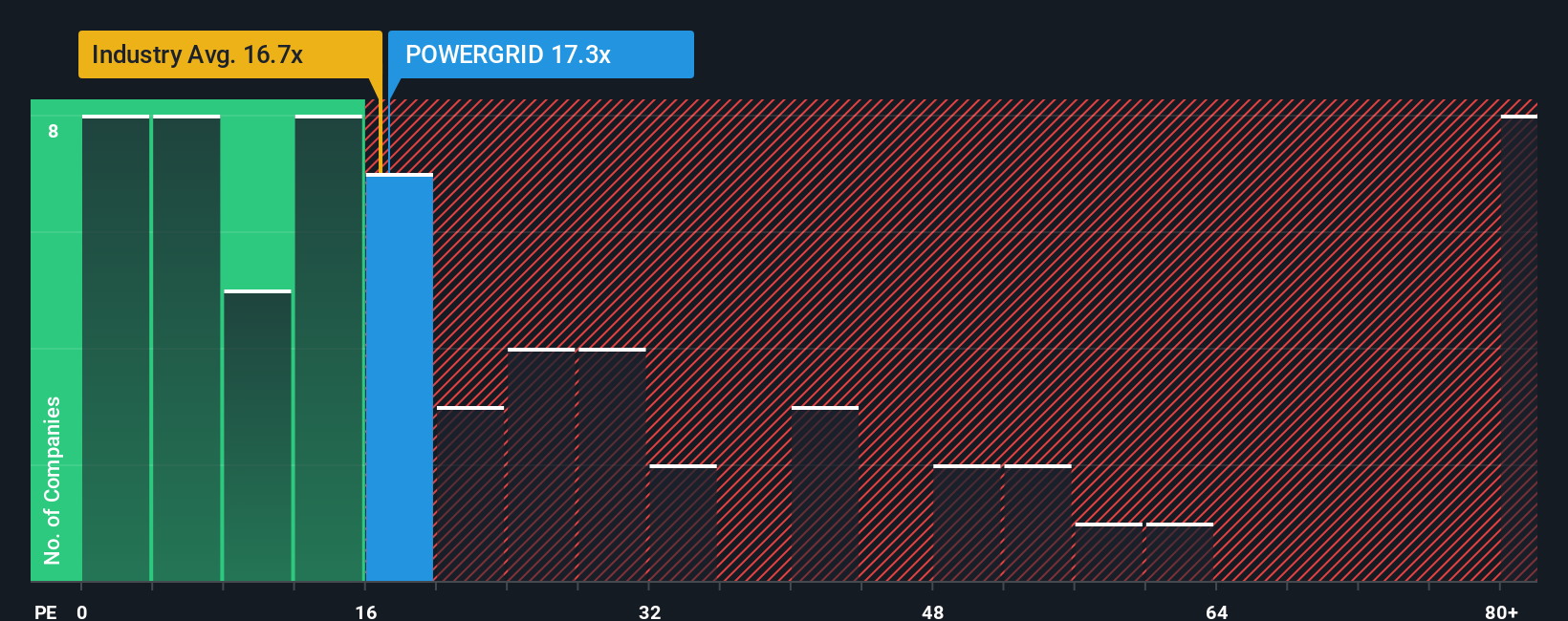- India
- /
- Electric Utilities
- /
- NSEI:POWERGRID
Earnings Working Against Power Grid Corporation of India Limited's (NSE:POWERGRID) Share Price
Power Grid Corporation of India Limited's (NSE:POWERGRID) price-to-earnings (or "P/E") ratio of 17.3x might make it look like a buy right now compared to the market in India, where around half of the companies have P/E ratios above 29x and even P/E's above 55x are quite common. Although, it's not wise to just take the P/E at face value as there may be an explanation why it's limited.
While the market has experienced earnings growth lately, Power Grid Corporation of India's earnings have gone into reverse gear, which is not great. It seems that many are expecting the dour earnings performance to persist, which has repressed the P/E. If you still like the company, you'd be hoping this isn't the case so that you could potentially pick up some stock while it's out of favour.
See our latest analysis for Power Grid Corporation of India

Does Growth Match The Low P/E?
In order to justify its P/E ratio, Power Grid Corporation of India would need to produce sluggish growth that's trailing the market.
If we review the last year of earnings, dishearteningly the company's profits fell to the tune of 1.7%. Regardless, EPS has managed to lift by a handy 5.5% in aggregate from three years ago, thanks to the earlier period of growth. Accordingly, while they would have preferred to keep the run going, shareholders would be roughly satisfied with the medium-term rates of earnings growth.
Shifting to the future, estimates from the nine analysts covering the company suggest earnings should grow by 6.8% each year over the next three years. Meanwhile, the rest of the market is forecast to expand by 19% per year, which is noticeably more attractive.
With this information, we can see why Power Grid Corporation of India is trading at a P/E lower than the market. Apparently many shareholders weren't comfortable holding on while the company is potentially eyeing a less prosperous future.
The Final Word
It's argued the price-to-earnings ratio is an inferior measure of value within certain industries, but it can be a powerful business sentiment indicator.
As we suspected, our examination of Power Grid Corporation of India's analyst forecasts revealed that its inferior earnings outlook is contributing to its low P/E. Right now shareholders are accepting the low P/E as they concede future earnings probably won't provide any pleasant surprises. It's hard to see the share price rising strongly in the near future under these circumstances.
Having said that, be aware Power Grid Corporation of India is showing 2 warning signs in our investment analysis, and 1 of those is potentially serious.
If you're unsure about the strength of Power Grid Corporation of India's business, why not explore our interactive list of stocks with solid business fundamentals for some other companies you may have missed.
New: Manage All Your Stock Portfolios in One Place
We've created the ultimate portfolio companion for stock investors, and it's free.
• Connect an unlimited number of Portfolios and see your total in one currency
• Be alerted to new Warning Signs or Risks via email or mobile
• Track the Fair Value of your stocks
Have feedback on this article? Concerned about the content? Get in touch with us directly. Alternatively, email editorial-team (at) simplywallst.com.
This article by Simply Wall St is general in nature. We provide commentary based on historical data and analyst forecasts only using an unbiased methodology and our articles are not intended to be financial advice. It does not constitute a recommendation to buy or sell any stock, and does not take account of your objectives, or your financial situation. We aim to bring you long-term focused analysis driven by fundamental data. Note that our analysis may not factor in the latest price-sensitive company announcements or qualitative material. Simply Wall St has no position in any stocks mentioned.
About NSEI:POWERGRID
Power Grid Corporation of India
An electric power transmission utility, engages in the power transmission business in India and internationally.
Established dividend payer and slightly overvalued.
Market Insights
Community Narratives



